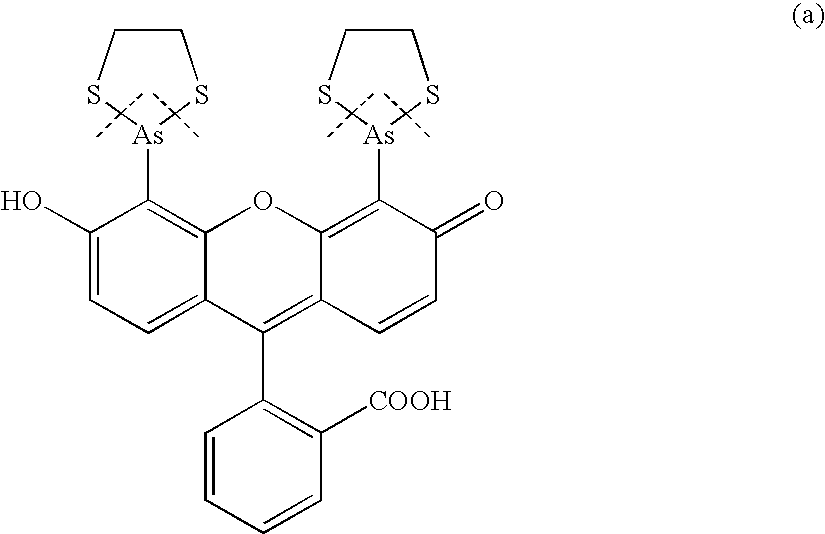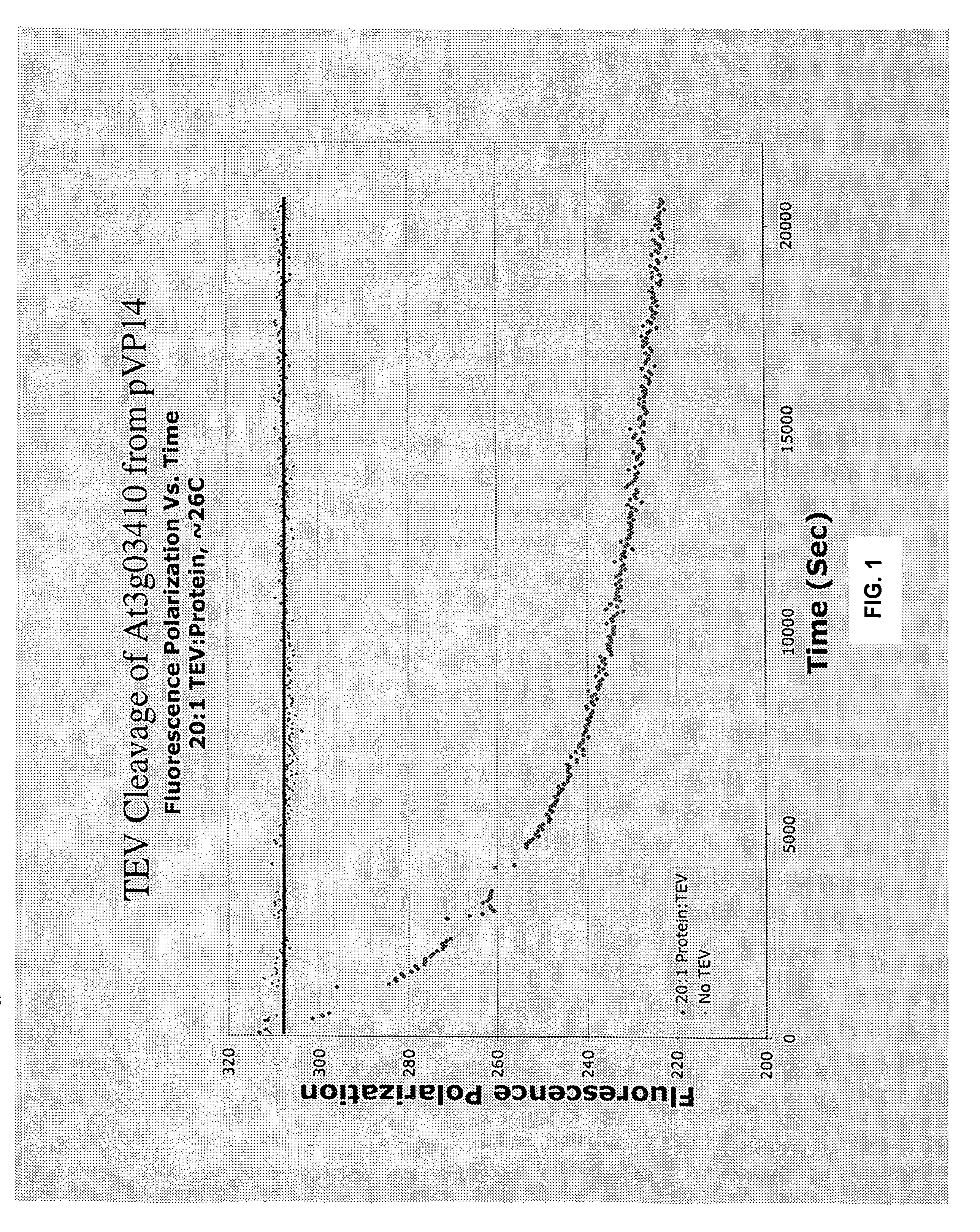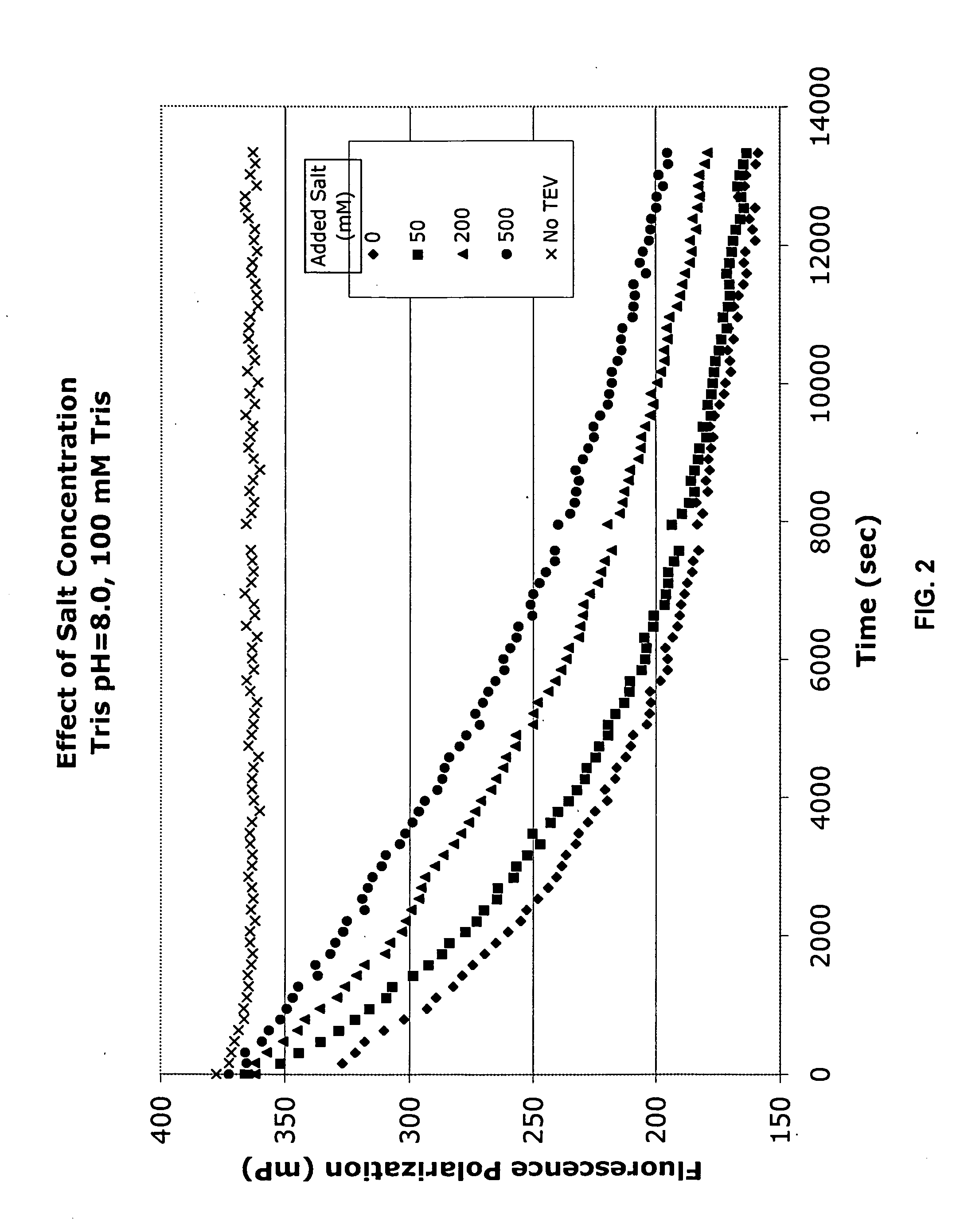Fluorescence polarization assay to detect protease cleavage
a protease and fluorescence polarization technology, applied in the field of elucidating protein interactions, can solve the problems of only providing quantitative data, only showing limited forms of data, and analytic methods are not amenable to investigating peptides or proteins, so as to improve the specificity, improve the specificity, and improve the thermal stability
- Summary
- Abstract
- Description
- Claims
- Application Information
AI Technical Summary
Benefits of technology
Problems solved by technology
Method used
Image
Examples
example 1
Fluorescence Polarization of a Peptide Cleaved by the Tobacco Etch Virus (TEV)
[0077] A vector was constructed having segments comprising a His tag for purification purposes, the tetraCys tag motif, a tobacco etch virus (TEV) cleavage site, and a target protein being investigated. The vector, named pVP-14 (SEQ. ID. NO: 2), was derived from pDEST17 (Invitrogen, Carlsbad, Calif., Cat. No. 11803-012) and encodes the expressed sequences:
[0078] His-tetraCys tag-TEV-Target protein, where “His” denotes a poly-His purification tag, “tetraCys tag” denotes the fluorescence tag, “TEV” denotes the tobacco etch virus cleavage sequence, and “target protein: denotes a protein or peptide sequence of interest.
[0079] The pVP14 vector was created from pDEST17 using the ExSite-brand site-directed mutagenesis kit (Stratagene, La Jolla, Calif.). The forward primer (FLUF) was 5′-phosphorylated and further comprised the sequence TGT TGC CCA GGA TGC TGT ACA AGT TTG TAC AAA AAA GCT GAA CGA GAA (SEQ. ID. NO...
example 2
Fluorescence Polarization of a Peptide Conjugated to a Solubility Protein
[0081] A vector was constructed having a His tag for purification purposes, a solubility tag comprising a maltose binding protein (MBP), a tobacco etch virus (TEV) cleavage site, a second His tag, the tetraCys tag, a second TEV site, and the target protein. The vector named pVP-15 (SEQ. ID. NO: 5) is derived from pVP13-GW (SEQ. ID. NO: 6). The pVP13-GW vector is derived from pQE80 (SEQ. ID. NO: 7), which is available commercially from Qiagen (Valencia, Calif.). pVP-15 includes the expressed sequences:
[0082] His-MBP-TEV-His-tetraCys tag-TEV-target protein.
[0083] The plasmid pVP13-GW, a pQE-80-derived vector used for expression of Arabidopsis thaliana genes in E. coli at University of Wisconsin Center for Eukaryotic Structural Genomics, was used as the parent for production of pVP 15. Proteins expressed from pVP13-GW contain an S-Tag for detection (Kim & Raines (1993) Protein Sci. 2:348-356), a His6 tag for pu...
example 3
Cleavage Efficiency of the Tobacco Etch Virus Protease in Various Solutions as Measured by Fluorescence Polarization
[0180] The following series of Examples exemplify the efficacy of using the disclosed invention in measuring protease cleavage in the presence of various potentially interfering compounds. Briefly, each reaction comprised mixing three components: 1) a mixture of labeled and unlabeled protease substrates; 2) TEV protease; and 3) the potentially interfering additive. The results are presented graphically in FIGS. 3-14 The reaction buffer contained the following components (final concentrations noted):
[0181] Tris,20 mM
[0182] TCEP, 0.3 mM
[0183] BME, 1 mM
[0184] EDTA, 2.5 mM
[0185] At3g16990 in pVP15 (unlabeled), 9 μM
[0186] At3g16990 in pVP15 (tetraCys-labeled), 16 nM
[0187] TEV Protease, 0.5 μM
[0188] pH 8.0
TCEP=tri(2-carboxyethyl)phosphine hydrochloride (reducing agent)
BME=P-mercaptoethanol (reducing agent)
EDTA=ethylenediaminetetraacetic acid (chelating agent) ...
PUM
| Property | Measurement | Unit |
|---|---|---|
| pH | aaaaa | aaaaa |
| temperature | aaaaa | aaaaa |
| temperature | aaaaa | aaaaa |
Abstract
Description
Claims
Application Information
 Login to View More
Login to View More - R&D
- Intellectual Property
- Life Sciences
- Materials
- Tech Scout
- Unparalleled Data Quality
- Higher Quality Content
- 60% Fewer Hallucinations
Browse by: Latest US Patents, China's latest patents, Technical Efficacy Thesaurus, Application Domain, Technology Topic, Popular Technical Reports.
© 2025 PatSnap. All rights reserved.Legal|Privacy policy|Modern Slavery Act Transparency Statement|Sitemap|About US| Contact US: help@patsnap.com



